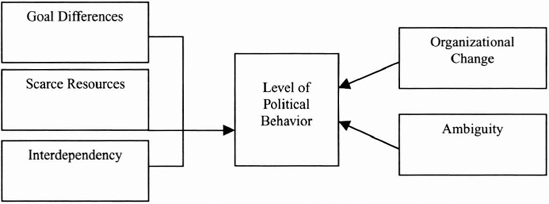10.3. Strategic Contingencies Model of Political Behavior
The strategic contingencies model of power and influence identifies issues, activities, and resources that are critical for organizations to achieve their goals (Salancik and Pfeffer, 1977). The model has two parts. The first part explains why some activities in organizations are political in nature; the second part explains how and why a specific subunit, such as product development, accrues political power in the organization.
10.3.1. Level of Political Activity
According to the strategic contingencies model, several conditions result in political behavior in organizations (see Figure 10.1) (Pfeiffer, 1981). Each of these conditions is discussed below. From this discussion it will become clear that several of these conditions are characteristic of the product development process.
Goal differences: Functional areas such as marketing and production may not share the same goals and objectives as product development. Differences in goals, metrics, and priorities between departments are common. These differences may result in conflicts as each group competes to achieve its respective goals.
Figure 10-1. PREDICTORS OF POLITICAL BEHAVIOR.

Scarce resources: All organizations are constrained by a finite set of resources such as money, technology, expertise, and so on. Product development activities will of necessity compete with ...
Get The PDMA Handbook of New Product Development now with the O’Reilly learning platform.
O’Reilly members experience books, live events, courses curated by job role, and more from O’Reilly and nearly 200 top publishers.

